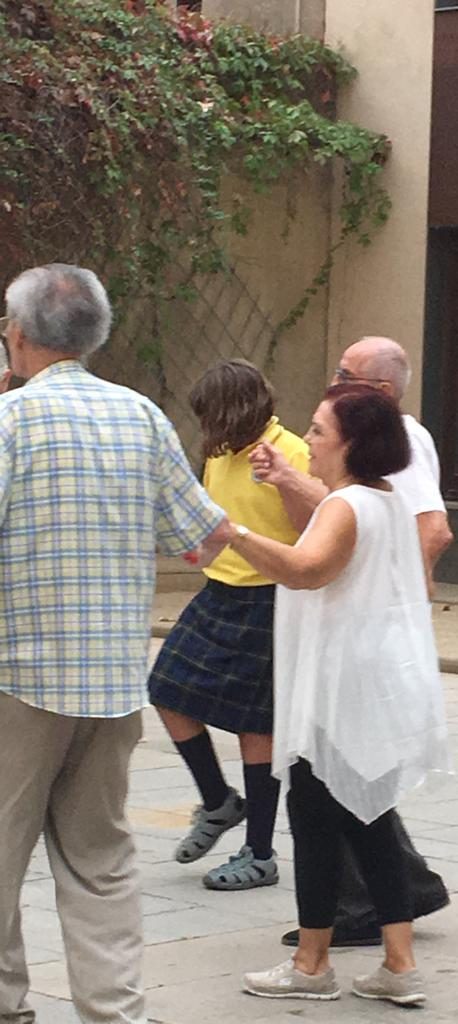Franco had no great love for Catalonians. I imagine they were difficult to subdue since Catalonians are independent and proud people with a rich, strong cultural heritage. In an effort to force them to unite with the rest of Spain, he banned spoken and written Catalan (the language of Catalonia) and many Catalonian traditions, such as the Sardana dance. (Although, some villages still held festivals and hosted dances in peaceful protest under Franco’s rule.) Their culture is a key part of the identify of the people here in Catalonia. Catalonians today teach their language to their children at home and in school (by law) and they share their beloved cultural traditions within their communities frequently and routinely – keeping their heritage as strong and rich as ever!
Those who have followed this blog know that Allita and I have already enjoyed several of these Catalonian traditions while staying in Casteldefels and now, in Sarria: festa major, cobla music, correfoc, Castellers, cercavila, gegants and capgrossos. In a few short weeks, we even plan to celebrate Castanyada (All Saints Day or Catalan Halloween) with our neighbors (more on that in an upcoming post)! Tonight, however, when we rejoined our Catalan community in celebrating their main annual festival, we were personally invited to participate in the Sardana!
One of the most significant cultural traditions in Catalonia is the Sardana dance. This dance is performed by members of the community who come together, hold hands and form a circle facing center. The cobla begins the music and a leader, an experienced dancer, calls out the steps. There are two basic patterns of dance steps: curts (short) and llargs (long). Dancers take small steps and the circle rotates slowly as the dance ensues.

Many of you already know a circle is a symbol of unity. For this reason, a dance that includes everyone and anyone – without any required costume – men, women, and children of all ages and backgrounds – connected together hand-in-hand, facing each other and moving in unison to music created by their own coblas, has powerful meaning for these people. They are joined in this circle; standing proud, raising their arms, smiling and laughing, perhaps even singing to the music, and moving together as one big connected group. Nothing could be a stronger statement of cultural pride and allegiance than the Sardana.
Tonight, Mom and Allita walked home from school and I met them, as we had planned, in the Plaça de Pere Figuera i Serra in the heart of Sarria. According to the schedule for the Festa Major 2019, this was the location for the Ballada de Sardanes [Sardana Dance]. I was very excited because this was a rare opportunity for us to be able to observe this historical dance up close – easily and without a huge crowd to block our view. I hoped to be able to watch the dancers long enough to figure out the steps. Little did I know that the group was also watching both Allita and I as we practiced and pranced nearby.
In no time at all, a friendly, middle-aged lady came over and grabbed my hand. She asked me (in Spanish) if I spoke Spanish or French, because her English was “no good”, so I told her I spoke French because my Spanish is “no good”. She pulled me toward the group of dancers and demonstrated the steps, counting for each one: un, deux, trois [one, two, three]. I motioned for Allita to join me and another dancer came over to teach Allita, also in French! The only problem with that was – Allita’s French is “no good”. HA! We practiced together – counting in French and sometimes in Spanish – while the remaining dancers observed, gave occasional pointers and prepared for the next round of Sardana.

Allita and I dancing 
Allita dancing 
Allita and I dancing
Then, the music started and the leader called “tirada de curts [short steps]” and we began. I held my hands down, matching the other dancers, and took small, precise steps counting under my breath and trying to advance slowly in a counter-clockwise procession. Then, the leader called “tirada de llargs [long steps]” and we raised our arms and switched to the second pattern of the dance that I had only just learned. Allita and I fumbled a little, now and then, but we recovered quickly and fell into step with the others at each transition. In the end, the dancers smiled and clapped and thanked us for joining them and we thanked them profusely and enthusiastically for including us. What a fantastic moment! I was so energized, I wanted to dance all night long. Unfortunately, just then, it started to rain and we all decided to head back home for an early dinner in our warm, dry abode instead.
We will miss the Correfoc on Friday because we are headed to Zurich for a weekend with friends on the Bodensee (more on that in a future post!). In fact, this was our last evening at the Festa Major de Sarria 2019. All-in-all, it was time well spent; meeting our neighbors, joining their celebration of all things Sarria and Catalonian, and making memories that will last a lifetime (or two, perhaps).
*the photos are courtesy of my mother who did not join us but was an active audience member.
Getting right into the swing of things! Looks like lots of fun!